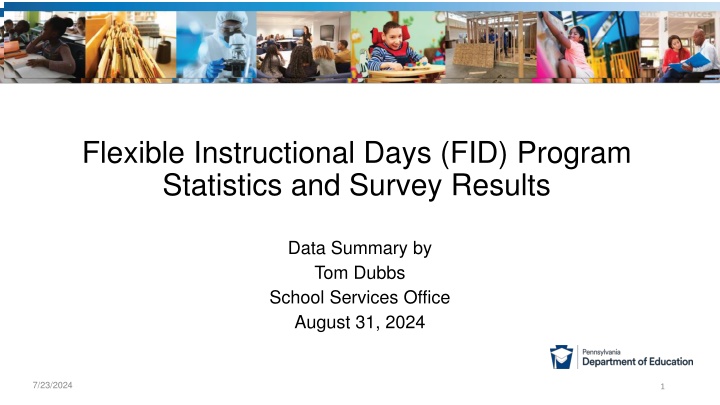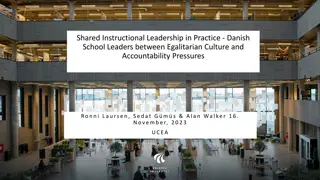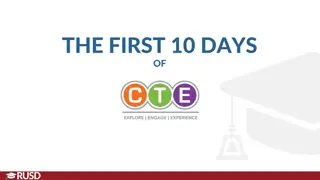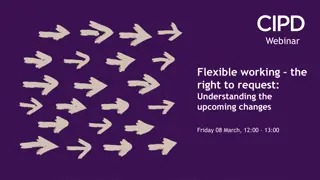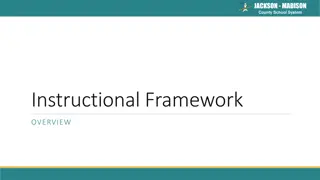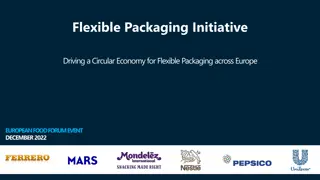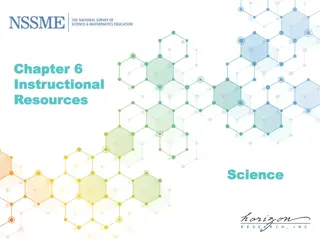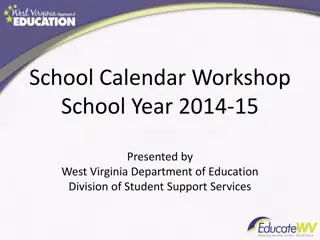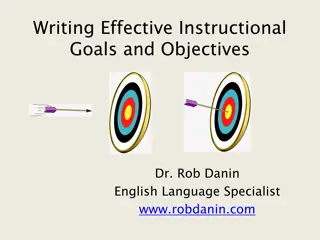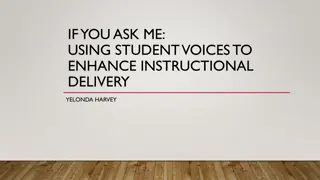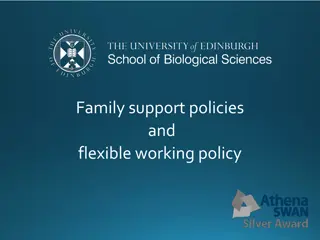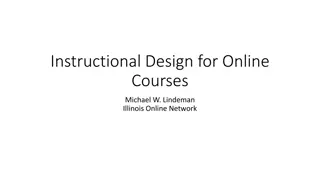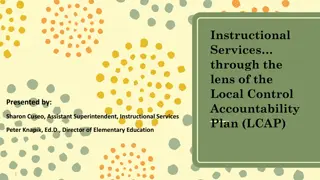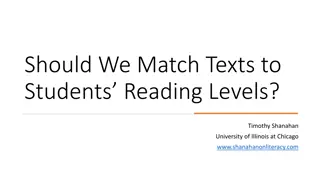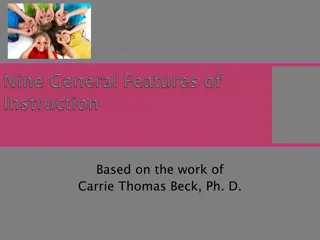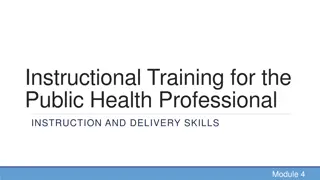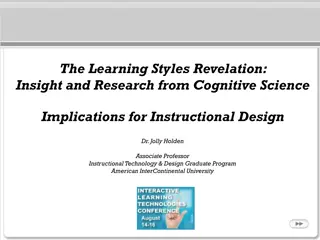Flexible Instructional Days (FID) Program Overview
The Flexible Instructional Days (FID) Program allows schools to provide remote instruction on days when traditional delivery is not feasible. Schools must apply to the Pennsylvania Department of Education (PDE) to participate in the program, which requires approval by the entity's governing body. FIDs are counted as instructional days and must meet specific criteria outlined by state laws. An annual survey assesses program effectiveness and areas for improvement.
Download Presentation

Please find below an Image/Link to download the presentation.
The content on the website is provided AS IS for your information and personal use only. It may not be sold, licensed, or shared on other websites without obtaining consent from the author.If you encounter any issues during the download, it is possible that the publisher has removed the file from their server.
You are allowed to download the files provided on this website for personal or commercial use, subject to the condition that they are used lawfully. All files are the property of their respective owners.
The content on the website is provided AS IS for your information and personal use only. It may not be sold, licensed, or shared on other websites without obtaining consent from the author.
E N D
Presentation Transcript
Flexible Instructional Days (FID) Program Statistics and Survey Results Data Summary by Tom Dubbs School Services Office August 31, 2024 7/23/2024 1
FID Program Background A Flexible Instructional Day (FID) program can support public school entities when circumstances prevent the delivery of instruction in its customary manner or location. 24 P.S. 15-1506 permits school districts, career and technical schools (CTCs), intermediate units (IUs) and charter schools defined under section 1703-A to use up to five days of remote instruction for specific reasons detailed in section 1506 (weather related closures, closures due to law enforcement and other types of emergencies) to meet the 180-day requirement. The program was piloted in 2014 and permanently established for the 2019-20 School Year. 7/23/2024 2
FID Program Background All students must be able to participate on the FID. Entities must apply to PDE to use the program. An FID program must be approved by the governing body of an entity prior to implementation. Once an application is accepted, the program is in effect for three years. After three years, the entity can choose whether to reapply. 7/23/2024 3
Instructional Time Policy Updates Beginning with the 2023-2024 school year and continuing each school year thereafter, school districts, career and technology centers, and intermediate units ( local educational agencies" or LEA") must provide a minimum of either 180 days of instruction for pupils, OR 450 hours of instruction for half-time pre-kindergarten and kindergarten, 900 hours of instruction for full-time pre-kindergarten and kindergarten and elementary (grades 1-6), and 990 hours of instruction for secondary (grades 7-12). An LEA may vary instructional time models by school building and/or grade level. FIDs are counted as days, not instructional hours. FIDs are tracked the same as any other instructional day in terms of Child Accounting. 7/23/2024 4
FID Data Sources Annual Survey State law requires the Pennsylvania Department of Education (PDE) to conduct an annual survey of all school entities accepted to offer FID programs. Survey questions focus on: Use of FIDs Program effectiveness Areas of Improvement The entity s likelihood of continuing the program Annual FID Application Process and Program Data Applications are submitted starting on April 1st with a deadline of June 1st. PDE must make final determinations by no later than August 1st. PDE posts a list of accepted applications on its website annually. PDE collects an maintains the following info from the Application Window: Number of applications submitted Applicant type of entity (School District, CTC, Charter School, or IU) Application status (renewal, new applicant, reapplication, inactive; non-renewal, never applied) Effective and termination dates 7/23/2024 5
Accepted Applications By Year 300 279 277 105 FID applications were accepted in the first year of implementation (2019-20). 250 PDE accepted 279 applications in 2020- 21. These applicants needed to reapply on or prior to the 2023-24 SY or lose the ability to offer the program. In total, 277 applied for the 2023-24 SY. 200 178 137 136 150 105 100 PDE accepted 178 applications for the 2024-25 SY. 50 0 2019-20 2020-21 2021-22 2022-23 2023-24 2024-25 7/23/2024 6
FID Usage Among Eligible Entities 559 entities are permitted to use FIDs for the 2024-25 SY, accounting for 73% of all eligible entities statewide. Another 18% of entities have never applied/never been accepted for the program. The remaining 9% of entities had an accepted application at some point, but then decided not to reapply and therefore, lost the program. They may reapply, should they desire to do so. Accepted Active Applicants Declined/Former User Never Used 18% 9% 73% 7/23/2024 7
Number of FIDs Used Since 2019-20, between 39% and 71.5% of eligible school entities with FID programs did use at least one FID. The 2023-24 SY had the highest level of use (71.5%) since the program s inception. In general, most used one to four days each year. During 2023-24 SY, approximately 7% of eligible school entities used or exceeded the maximum number of five days allowed. None 1-2 days 3-4 days 5 days 6+ 47.6 2019-20 SY 2.9 8.6 23.8 17.1 2020-21 SY 60.2 11.3 12.8 15.7 39.0 2021-22 SY 35.4 15.4 10.1 0 50.8 2022-23 SY 32 11.5 5.6 28.5 2023-24 SY 36.9 27.8 6.2 0.6 0 20 40 60 80 100 7/23/2024 8
General Statistics: 2024-25 SY Accepted Applicants School Districts CTC/AVTS Charter Schools Intermediate Units 418 school districts in PA have FID programs. This accounted for 75% of all entities with accepted applications. Charter Schools (15%), CTC/AVTS (8%), and IUs (2%) accounted for the remainder of accepted applicants. 2% 15% 8% 75% 7/23/2024 9
2024-25 SY Accepted Applications More than one-half (56.2%) 2024-25 SY applicants were program renewals. Had they not reapplied and been accepted, the entities would have lost the program for 2024-25 SY. 16.9% of applicants were accepted for the first time. Another 14.6% of applicants applied for renewal before their programs were set to expire. This was primarily related to dramatic changes in the program, leadership, or contracts at the entities. The remaining 12.4% of applicants had lost the program because they did not reapply, but decided to do so this year and were accepted for another three years. 12.4% 14.6% 16.9% 56.2% Early Renewal Renewal New Applicant Re-entry 7/23/2024 10
Overall Program Effectiveness 100.0 3.2 3.3 5.5 4.3 6.6 96.8% perceived their programs as very effective or somewhat effective in providing FIDs in the 2023-24 SY, slightly more than the prior year (95.7%). 90.0 16.1 15.0 17.4 17.6 25.3 80.0 70.0 60.0 Now that we have been using the FID protocol for a number of years and have worked out the bugs, our parents, staff, and students are familiar with the process. The days used this year were pretty seamless. Our FID process has been in place for numerous year. We are 1-1 district, and our ability to implement an FID has become part of our instructional process, much more effective than in earlier years. PDE does not endorse these unedited comments from 2023-24 SY survey respondents, but has provided them to give the reader different perspectives from Public School entities with accepted FID applications. 50.0 80.7 80.7 40.0 79.3 77.9 68.1 30.0 20.0 10.0 0.0 2019-20 SY 2020-21 SY 2021-22 SY 2022-23 SY 2023-24 SY Very Effective Somewhat Effective Not Effective 7/23/2024 11
Providing Timely Notifications That An FID Was Implemented Effectiveness Rating During the 2023-24 SY, 94.9% considered their programs to be very effective in providing notifications about an FID. We were able to properly notify our families about our FID virtual instructional day. Our families were able to pivot to this instructional model so that learning could continue. These days are helpful to us as a district. 100.0 3.7 1.3 2.6 3 3.3 4.0 6.4 90.0 16.4 11.0 23.8 80.0 70.0 60.0 50.0 94.9 94.4 82.7 80.3 40.0 72.2 30.0 20.0 10.0 0.0 PDE does not endorse these unedited comments from 2023-24 SY survey respondents, but has provided them to give the reader different perspectives from Public School entities with accepted FID applications. 2019-20 SY 2020-21 SY 2021-22 SY 2022-23 SY 2023-24 SY Very Effective Somewhat Effective Not Effective 7/23/2024 12
Communicating Roles and Responsibilities to Teachers, Staff, Parents/Caregivers 100.0 1.6 2.8 Effectiveness Rating 92.5% perceived themselves as very effective in communicating roles to teachers, staff, parents, and students. Each year, we have improved our communication efforts with parents, students, and staff on what an FID is and what is expected. We have proactively provided notice to everyone early in the school year and then reminders when the winter season approaches. Overall, we have utilized the days effectively and productively to meet the needs of our schools. 3.0 4.6 7.6 5.9 8.1 7.6 9.2 90.0 15.2 80.0 70.0 60.0 50.0 92.5 89.2 89.1 86.2 40.0 77.2 30.0 20.0 10.0 0.0 2019-20 SY 2020-21 SY 2021-22 SY 2022-23 SY 2023-24 SY PDE does not endorse these unedited comments from 2023-24 SY survey respondents, but has provided them to give the reader different perspectives from Public School entities with accepted FID applications. Very Effective Somewhat Effective Not Effective 7/23/2024 13
Utilizing Technology in Delivering Instruction and in Facilitating Learning 100.0 2.4 3.6 3.3 4.9 6.0 Effectiveness Rating The number of FID users that considered themselves as very effective in utilizing technology to deliver instruction was 81%. 12.2 90.0 16.3 18.2 16.5 24.6 80.0 70.0 60.0 50.0 84.2 81 40.0 78.2 77.5 70.5 By regularly using Google Classroom, we are able to exercise FIDs. 30.0 20.0 The transition to FIDs was quite seamless, as proactive communication was distributed and all students have access to developmentally appropriate devices. 10.0 0.0 2019-20 SY 2020-21 SY 2021-22 SY 2022-23 SY 2023-24 SY Very Effective Somewhat Effective Not Effective PDE does not endorse these unedited comments from 2023-24 SY survey respondents, but has provided them to give the reader different perspectives from Public School entities with accepted FID applications. 7/23/2024 14
Providing equitable accommodations for students and staff lacking sufficient access to devices and/or Internet 100.0 Effectiveness Rating In the 2023-24 SY, 73.2% of entities perceived themselves as very effective in providing devices and/or access to the Internet for students and staff. 3.7 3.5 4.2 4.8 6.7 90.0 20.8 22.5 23.2 25.6 80.0 31.8 70.0 60.0 With our district being 1:1, the process to conduct an FID was much easier than anticipated. 50.0 40.0 75 73.8 73.2 69.4 We serve the entire County and we still have areas without high speed Internet. 61.5 30.0 20.0 Access to reliable technology for all students is sometimes challenging. PDE does not endorse these unedited comments from 2023-24 SY survey respondents, but has provided them to give the reader different perspectives from Public School entities with accepted FID applications. 10.0 0.0 2019-20 SY 2020-21 SY 2021-22 SY 2022-23 SY 2023-24 SY Very Effective Somewhat Effective Not Effective 7/23/2024 15
Tracking Attendance During an FID 100.0 2.4 4.0 4.2 5.3 6.3 Effectiveness Rating While continuing to trend upward, entities continue to identify tracking attendance as an area in which they do not perceive themselves as very effective, compared to other aspects of the program. 90.0 21.7 21 23.8 29.8 80.0 33.9 70.0 60.0 50.0 Student attendance is taken via active participation in instruction during the school day. When a student completes a log-in, attendance is noted; however, completion of assignments is also considered for attendance purposes. 40.0 75.9 74.8 72.2 64.9 59.8 30.0 20.0 We need to do a better job with tracking attendance and making sure our students who are not one-to-one have meaningful academic work to complete. 10.0 0.0 2019-20 SY 2020-21 SY 2021-22 SY 2022-23 SY 2023-24 SY PDE does not endorse these unedited comments from 2023-24 SY survey respondents, but has provided them to give the reader different perspectives from Public School entities with accepted FID applications. Very Effective Somewhat Effective Not Effective 7/23/2024 16
Providing Instruction as a Natural Extension of Classroom Learning, Demonstrating a Continuous Progression of Course Objectives 100.0 3.5 4.3 4.2 6.3 8.3 90.0 Effectiveness Rating In the 2023-24 SY, 72.7% of FID entities considered themselves to be very effective providers of instruction as a natural extension of the classroom. 23.9 27.5 27.8 27.0 80.0 24.4 70.0 60.0 The system of using FID days has become a natural extension of teaching schedule. We consistently use Google Classroom as our platform for instruction throughout the year, so all learning materials are easily accessible to students throughout the year. 50.0 40.0 72.7 68.5 68 67.2 66.7 30.0 Providing instruction as a natural extension of classroom learning has been a struggle in a rural community. However, our communication has been great. 20.0 10.0 It is challenging to gauge meaningful participation and engagement. 0.0 2019-20 SY 2020-21 SY 2021-22 SY 2022-23 SY Not Effective 2023-24 SY Very Effective Somewhat Effective PDE does not endorse these unedited comments from 2023-24 SY survey respondents, but has provided them to give the reader different perspectives from Public School entities with accepted FID applications. 7/23/2024 17
Addressing the Needs of Students with IEPs or Other Special Considerations 100.0 3.8 3.9 4.6 7.9 9.4 Effectiveness Rating 69.2% of entities rated themselves as very effective in meeting the needs of students with IEPs and other special considerations. This has consistently been the area where FID users have not perceived their efforts as equal or better than other aspects of the program. 90.0 27.1 29.9 80.0 32.8 38.1 70.0 46.0 60.0 50.0 Special education teachers participate in all inclusion classes via Google Meet or Zoom. They also offer support periods for students to log in or call for assistance. 40.0 69.2 65.5 63.3 30.0 52.5 46.1 We have continued to enhance our technology integration to ensure that we are tracking attendance properly, ensuring access, supporting students with disabilities and English Language Learners. PDE does not endorse these unedited comments from 2023-24 SY survey respondents, but has provided them to give the reader different perspectives from Public School entities with accepted FID applications. 20.0 10.0 0.0 2019-20 SY 2020-21 SY 2021-22 SY 2022-23 SY Not Effective 2023-24 SY Very Effective Somewhat Effective 7/23/2024 18
Likelihood to Reapply 3.4 3.6 4.2 6.2 1.7 0.4 5.4 0 In 2023-24, 76.2% of entities were definitely planning to submit an application so they could continue to use the program. Another 14.4% of entities indicated that they would probably reapply. Only 9.6% of entities would not submit an application/reapply, or were uncertain. 90.6 12.0 1 14.4 1 80.6 70.6 60.6 50.6 83.0 81.0 80.3 40.6 76.2 30.6 We did not use any FID days this school year. We continue to build in snow days, but believe the availability of FIDs is important and will continue to seek approval for their use. 20.6 10.6 0.6 PDE does not endorse these unedited comments from 2023-24 SY survey respondents, but has provided them to give the reader different perspectives from Public School entities with accepted FID applications. 2020-21 2021-22 2022-23 2023-24 Definitely Probably Not Uncertain 7/23/2024 19
2023-24 SY FID Program Annual Survey Themes PDE does not endorse these general themes from 2023-24 SY survey respondents, but has provided them to give the reader different perspectives from Public School entities with accepted FID applications. Content Analysis of the Comments Section of the Survey Revealed: A considerable number of applicants did not use any FIDs this year, but they did like having the option and were prepared to implement if needed. Many districts are using more technology during in-person instruction so the transition to an FID is easier than in the past. An FID is a developing program so you need to continually improve and to fine tune implementation. Maintaining a structured scheduled, combining synchronous and asynchronous instruction enhances participation, attendance and engagement. 7/23/2024 20
2023-24 SY FID Program Annual Survey Themes PDE does not endorse these general themes from 2023-24 SY survey respondents, but has provided them to give the reader different perspectives from Public School entities with accepted FID applications. Content Analysis of the Comments Section of the Survey Revealed: Districts are hearing very few parent complaints, but FIDs can be burdensome to some parents. Rural districts and those that are not 1-1 face more challenges to insure that ALL students are in attendance and receiving instruction on an FID due to limited technology and Internet access. Some of the devices procured prior to or during COVID are now becoming outdated and may need to be replaced and there is no funding available to purchase new equipment. 7/23/2024 21
2023-24 SY FID Program Annual Survey Themes PDE does not endorse these general themes from 2023-24 SY survey respondents, but has provided them to give the reader different perspectives from Public School entities with accepted FID applications Content Analysis of the Comments Section of the Survey Revealed: In-person instruction is perceived as essential and is preferred over online instruction. As a result, districts continue to add snow days to the calendar. Some districts will only use an FID after all allocated snow/make-up days are used. In fact, there are employee and union contracts and School Board directives that require the use of snow/make-up days prior to implementing FIDs. In some districts, FIDs are the last resort strategy for delivering instruction to students, especially for entities with a lot of special needs students or low attendance rates. 7/23/2024 22
2023-24 SY FID Program Annual Survey Themes PDE does not endorse these general themes from 2023-24 SY survey respondents, but has provided them to give the reader different perspectives from Public School entities with accepted FID applications Content Analysis of the Comments Section of the Survey Revealed: Coordination of schedules between sending districts and CTCS or IU can be a challenge if they are not in synch or both do not have an FID program. Many entities will only use an FID if there is sufficient time in advance of the FID (i.e. a Nor easter is predicted for the area) for all learners, instructors, and staff to have the resources required to have a productive instructional day and that ALL may participate. Calling an FID due to an unforeseen situation (i.e. heavy overnight storm or loss of power throughout most of the district) can be difficult, resulting in some learners not being able to participate. Shifting from a two-hour delay to an FID can be very challenging. 7/23/2024 23
2023-24 SY FID Program Annual Survey Themes PDE does not endorse these general themes from 2023-24 SY survey respondents, but has provided them to give the reader different perspectives from Public School entities with accepted FID applications Content Analysis of the Comments Section of the Survey Revealed: More than five days or more flexibility should be given if an entity would have to close a building or the entire district for an extended amount of time for an unforeseen circumstance. Districts do like the ability to use an FID for one building, but in doing so, this uses one of the five FIDs for the year. The FID application process has been helpful because the applicant needs to develop an implementation plan that meets the needs of ALL students and provides a meaningful instruction for the learners. With the new changes to the 180 days or 900/990 hours of instruction as well as the guidance under Chapter 11 allowing a district the latitude to use remote learning as it deems appropriate, is the FID program necessary? 7/23/2024 24
Contact/Mission For more information on Flexible Instructional Days (FIDs), please visit PDE s website at www.education.pa.gov or you may email PDE at RA-FID@pa.gov. The mission of the Department of Education is to ensure that every learner has access to a world- class education system that academically prepares children and adults to succeed as productive citizens. Further, the Department seeks to establish a culture that is committed to improving opportunities throughout the commonwealth by ensuring that technical support, resources, and optimal learning environments are available for all students, whether children or adults. 7/23/2024 25
